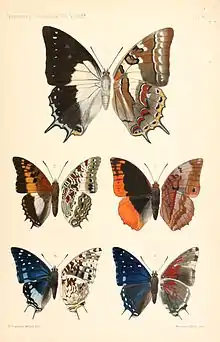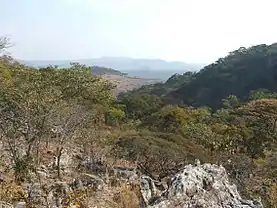| Charaxes ansorgei | |
|---|---|
 | |
| Male, Fig. 2 (middle, left) | |
| Scientific classification | |
| Domain: | Eukaryota |
| Kingdom: | Animalia |
| Phylum: | Arthropoda |
| Class: | Insecta |
| Order: | Lepidoptera |
| Family: | Nymphalidae |
| Genus: | Charaxes |
| Species: | C. ansorgei |
| Binomial name | |
| Charaxes ansorgei | |
Charaxes ansorgei is a butterfly in the family Nymphalidae. It is found in Sudan, the Democratic Republic of Congo, Uganda, Rwanda, Burundi, Kenya, Tanzania, Malawi and Zambia.[3] The habitat consists of montane forest on altitudes between 2,000 and 3,000 meters. The larvae feed on Bersama abyssinica abyssinica, Bersama abyssinica englerana and Bersama paullinoides.It was once considered to be a very rare species but it is relatively common in dense and inaccessible montane forests [4]

Description
Nearly allied to the preceding species Charaxes brutus, but has the basal part of the forewing above chestnut-brown, not black; the discal band of the hindwing is bluish white. Male- discal band of the fore wing ochre-yellow, continuous to vein 4, then broken up into spots, one each in cellules 4 and 7 and two each in 5 and 6; on the proximal side of the discal band the ground-colour forms black spots in cellules 2—6; small light marginal dots; hindwing with orange-yellow submarginal spots in cellules 2—7 and 2 blue spots in 1 c; the tail at vein 4 somewhat shorter than that at vein 2. The female is larger than the male and has the median band on the forewing white, only at the costal margin somewhat yellowish; the tails of the hindwing are longer than in the male and the anterior longer than the posterior.[5] A full description is given by Rothschild, W. And Jordan, K., 1900 Novitates Zoologicae Volume 7:287-524. page 428-429 (for terms see Novitates Zoologicae Volume 5:545-601 )
Subspecies
- C. a. ansorgei (Uganda: slopes of Mount Elgon, Kenya: highlands west of the Rift Valley)
- C. a. jacksoni Poulton, 1933 [6] (Kenya: highlands east of the Rift Valley)
- C. a. kilimanjarica van Someren, 1967[7] (Tanzania: Kilimanjaro)
- C. a. kinyeti Plantrou, 1989[8] (Sudan (south to Imatong, Kinyeti and Didinga Mountains)
- C. a. kungwensis van Someren, 1967 (Tanzania: eastern shores of Lake Tanganyika)
- C. a. levicki Poulton, 1933 (southern highlands of Tanzania, Malawi, Zambia)
- C. a. loita Plantrou, 1982 [9] (southern Kenya, northern Tanzania)
- C. a. ruandana Talbot, 1932 [10](south-western Uganda, Rwanda, Burundi, Democratic Republic of Congo)
- C. a. rydoni van Someren, 1967 (north-eastern Tanzania)
- C. a. simoni Turlin, 1987 [11] (north-eastern Tanzania)
- C. a. ufipa Kielland, 1978[12] (western Tanzania)
Related species
Historical attempts to assemble a cluster of presumably related species into a "Charaxes jasius Group" have not been wholly convincing. More recent taxonomic revision,[13] corroborated by phylogenetic research, allow a more rational grouping congruent with cladistic relationships. Within a well-populated clade of 27 related species sharing a common ancestor approximately 16 mya during the Miocene,[14] 26 are now considered together as The jasius Group.[13] One of the two lineages within this clade forms a robust monophyletic group of seven species sharing a common ancestor approximately 2-3 mya, i.e. during the Pliocene,[14] and are considered as the jasius subgroup.[13] The second lineage leads to 19 other species within the Jasius group, which are split into three well-populated subgroups of closely related species.
The jasius Group (26 Species):[13]
Clade 1: jasius subgroup (7 species)
Clade 2: contains the well-populated three additional subgroups (19 species) of the jasius Group: called the brutus, pollux, and eudoxus subgroups.[13]
- the pollux subgroup (4 species):
- Charaxes pollux
- Charaxes phoebus
- Charaxes ansorgei
- Charaxes dowsetti
Further exploration of the phylogenetic relationships amongst existing Charaxes taxa is required to improve clarity.
See also
References
- ↑ Rothschild, W. 1897 Descriptions of some new species of Lepidoptera. Novitates Zoologicae 4: 179-184.
- ↑ Charaxes, Site of Markku Savela
- ↑ "Afrotropical Butterflies: File H - Charaxinae - Tribe Charaxini". Archived from the original on 2013-11-09. Retrieved 2012-05-22.
- ↑ Larsen, , T.B. 1991 The Butterflies of Kenya and their Natural History. Oxford University Press, Oxford: i-xxii, 1-490
- ↑ Aurivillius, [P.O.]C. 1908-1924. In: Seitz, A. Die Großschmetterlinge der Erde Band 13: Abt. 2, Die exotischen Großschmetterlinge, Die afrikanischen Tagfalter, 1925, 613 Seiten, 80 Tafeln (The Macrolepidoptera of the World 13).Alfred Kernen Verlag, Stuttgart.
 This article incorporates text from this source, which is in the public domain.
This article incorporates text from this source, which is in the public domain. - ↑ Poulton, E.B. 1933.The geographical races of Charaxes ansorgei, Roths. (Lep. Nymphalidae). Stylops 2: 12-16.
- ↑ van Someren , V.G.L. 1967 Revisional notes on African Charaxes (Lepidoptera: Nymphalidae). Part IV. Bulletin of the British Museum (Natural History) (Entomology) 18: 277-316.
- ↑ Mark C. Williams Checklist of Afrotropical Papilionoidea and Hesperoidea; Compiled by Mark C. Williams, 7th ed. (2008) (April 2007 Butterflies and Skippers of the Afrotropical Region
- ↑ Plantrou, J. 1982. Description de 9 sous-especes du genre Charaxes recemment decouvertes en Afrique (Lep. Nymphalidae). Miscellanea Entomologica 49: 101-115.
- ↑ Talbot, G. 1932 Four new forms of Rhopalocera. Bulletin of the Hill Museum, Witley 4: 288-289.
- ↑ Turlin, B. 1987. Descriptions de nouvelles sous-especes et d’une forme de Charaxes africains (Lepidoptera Nymphalidae). Bulletin de la Societe Scientifique Naturelle No. 53: 19-25
- ↑ Kielland, J. 1978. A provisional checklist of the Rhopalocera of the eastern side of Lake Tanganyika. Tijdschrift voor Entomologie 121 (4): 147-237
- 1 2 3 4 5 Turlin, B. (2005). Bauer & Frankenbach (ed.). Butterflies of the World: Charaxes 1. Vol. 22. Keltern: Goecke & Evers. pp. 2–3. ISBN 3937783156.
- 1 2 "Out of Africa again: A phylogenetic hypothesis of the genus Charaxes (Lepidoptera: Nymphalidae) based on five gene regions" Archived 2019-07-25 at the Wayback Machine. Aduse-Poku, Vingerhoedt, Wahlberg. Molecular Phylogenetics and Evolution (2009) 53;463–478
External links
- Images of C. ansorgei ansorgei Royal Museum for Central Africa (Albertine Rift Project)
- Images of C. ansorgei jacksoni Royal Museum for Central Africa (Albertine Rift Project)
- Images of C. ansorgei kungwensis Royal Museum for Central Africa (Albertine Rift Project)
- Images of C. ansorgei levicki Royal Museum for Central Africa (Albertine Rift Project)
- Images of C. ansorgei ruandan Royal Museum for Central Africa (Albertine Rift Project)
- Charaxes ansorgei images at Charaxes page Consortium for the Barcode of Life subspecies and forms
- African Butterfly Database Range map via search